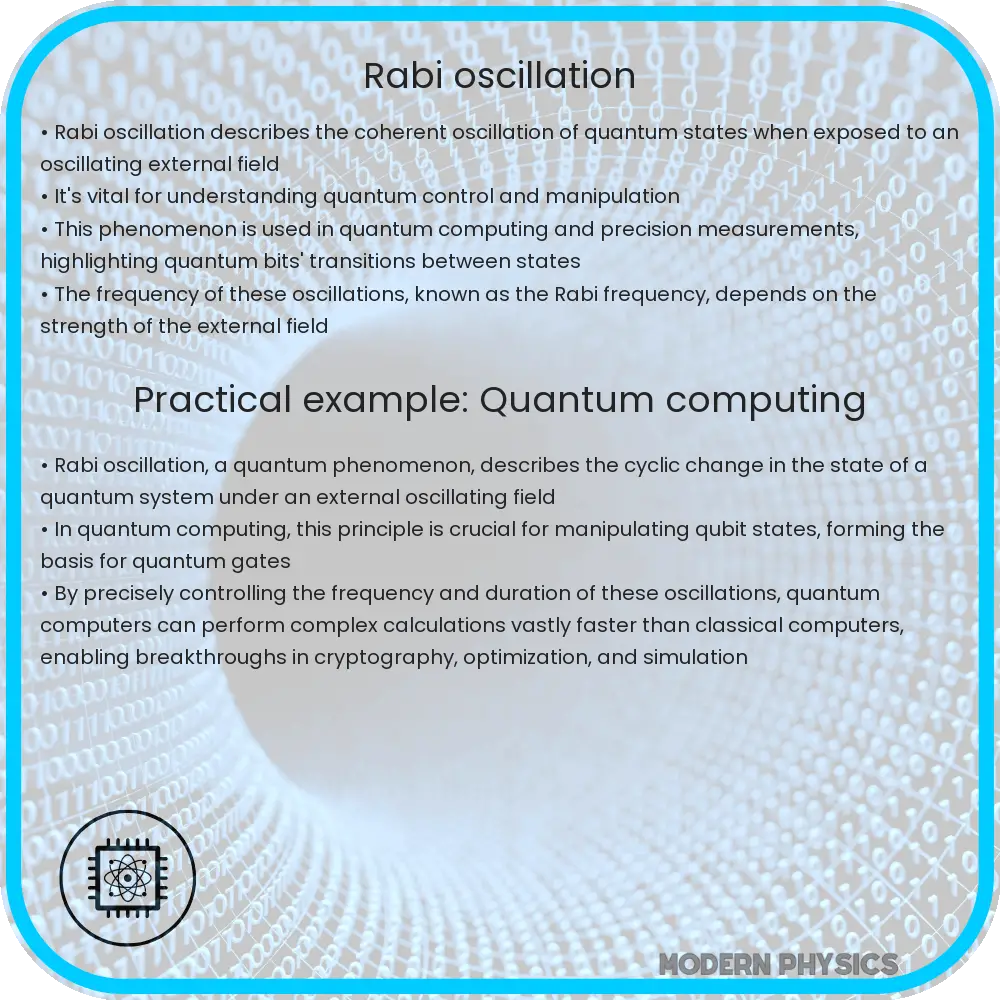Explore the fascinating world of Rabi Oscillations, their role in quantum dynamics, coherence, and QED, and their impact on quantum computing.

Rabi Oscillations: Fundamentals and Applications in Quantum Dynamics
Rabi Oscillations, a fundamental concept in quantum mechanics, are named after Isidor Isaac Rabi, who first theorized them in 1937. They describe the oscillatory behavior of a two-level quantum system in the presence of an oscillating external field, typically a magnetic or electric field. These oscillations are crucial for understanding the dynamics of quantum systems and have significant implications in Quantum Electrodynamics (QED) and coherence phenomena in quantum computing.
Understanding the Quantum Two-Level System
At the heart of Rabi Oscillations is the concept of a quantum two-level system. Such a system can be represented by two states, often denoted as |0⟩ and |1⟩. These states can correspond to various physical phenomena, such as the spin states of an electron or the energy levels of an atom. When an external oscillating field, like a magnetic field, is applied, it causes transitions between these two states. This interaction is described by the Rabi formula:
Ω = γB0
where Ω is the Rabi frequency, γ represents the gyromagnetic ratio, and B0 is the magnetic field strength. The Rabi frequency dictates the rate of oscillation between the states.
Coherence and Quantum Dynamics
Coherence is a key element in quantum dynamics and quantum computing. It refers to the ability of quantum states to exhibit interference effects due to their wave-like nature. Rabi Oscillations are a direct manifestation of this coherence. They demonstrate how a quantum system evolves coherently under the influence of an external field. This evolution is critical in quantum computing, where coherent manipulation of qubits (quantum bits) is essential for performing calculations.
Role in Quantum Electrodynamics (QED)
Quantum Electrodynamics, the quantum theory of electromagnetic fields, also finds Rabi Oscillations integral to its framework. QED deals with the interactions between light (photons) and matter (electrons, atoms), and Rabi Oscillations provide a way to understand and quantify these interactions. Particularly, they help in understanding how atoms absorb and emit photons, a process central to the theory of QED.
In summary, Rabi Oscillations are not just a theoretical construct but have practical applications in various fields of quantum physics. Their role in understanding and manipulating quantum states makes them indispensable in the advancement of quantum computing and quantum electrodynamics.
Applications in Quantum Computing and Beyond
One of the most groundbreaking applications of Rabi Oscillations is in the field of quantum computing. Here, the precise control of qubits is paramount. Rabi Oscillations provide a mechanism to manipulate these qubits by toggling them between their two states. By controlling the duration and strength of the external field, quantum computers can perform complex calculations at speeds unattainable by classical computers. This capability is crucial for tasks like large-scale data processing, cryptography, and solving complex algorithms.
Experimental Observation and Challenges
The experimental observation of Rabi Oscillations is a testament to the advancement in quantum technologies. Techniques like nuclear magnetic resonance (NMR) and electron spin resonance (ESR) are commonly used to observe these oscillations. However, maintaining coherence for a sufficient duration, a prerequisite for observing Rabi Oscillations, poses a significant challenge. Quantum systems are prone to decoherence, a process where the system loses its quantum properties due to interaction with the environment. Advanced techniques in quantum error correction and isolation of quantum systems are being developed to address this issue.
Future Prospects and Research
Continued research in harnessing and controlling Rabi Oscillations is opening new frontiers in quantum technology. For instance, their application in quantum sensors could lead to devices with unprecedented precision. Moreover, understanding Rabi Oscillations better could pave the way for more efficient quantum communication systems, a key component of the emerging quantum internet.
Conclusion
In conclusion, Rabi Oscillations are a cornerstone in the understanding of quantum mechanics and quantum electrodynamics. Their role extends from theoretical physics to practical applications in quantum computing, communication, and sensing. As our ability to control and observe these oscillations improves, so does our potential to harness the power of quantum mechanics. The ongoing research and development in this field are not just expanding our understanding of the quantum world but are also paving the way for technological revolutions that could transform our world.
